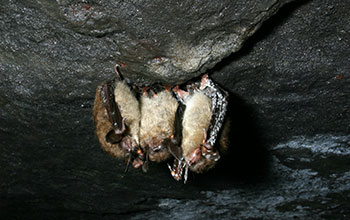Multimedia Gallery
A cluster of northern long-eared bats
A cluster of northern long-eared bats (Myotis septentrionalis). This species has largely disappeared from caves and mines due to infection from white-nose syndrome.
More about this image
In the winter, bats gather by the thousands in caves and mine shafts to stay away from the elements. It is this proximity to one another during hibernation, along with the caves' and mines' natural humidity, that has fueled the outbreak of one of the worst bat diseases in history: white-nose syndrome (WNS).
WNS is caused by the fungus Pseudogymnoascus destructans, which results in a skin infection, a distinctive white growth around the muzzles and on the wings of bats. As of 2012, the disease was linked to some 6.7 million North American bat deaths.
It is believed the fungus was most likely carried to the U.S. by humans traveling to and from Europe, where it is widespread. However, in Europe to date, no mass mortality has been documented, although researchers do not know why.
Winifred Frick, a biologist at the University of California, Santa Cruz, and colleagues published a paper detailing the disease in 468 bat colonies in six states in which the disease has been present for several years. These include Vermont, New York, Pennsylvania, Maryland, Virginia and West Virginia.
The scientists compared the results to those from 640 colonies in eight European countries including Norway, the United Kingdom, the Netherlands, Belgium, France, Portugal, the Czech Republic and Bulgaria. Of these nations, WNS has been confirmed in all except Norway, where no surveys have yet been taken.
"We used four decades of population counts in 16 species of hibernating bats to determine the effect of WNS on bats in North America compared to those in Europe," says Frick. The results: WNS caused a 10-fold decrease in colony sizes of hibernating bats in eastern North America, a dramatic decline across multiple bat species.
The northern long-eared bat (Myotis septentrionalis) is probably the most affected. So much so that it is being considered for listing under the U.S. Endangered Species Act. These bats have vanished from some 69 percent of the hibernacula where they were once found.
"Mortality from WNS has placed this bat species in peril," says Frick. "It now appears at significant risk of extinction."
This research was supported by the joint National Science Foundation (NSF)-National Institutes of Health-Department of Agriculture Ecology and Evolution of Infectious Diseases program (grant DEB 1115895).
To learn more, see the NSF Discovery story Hibernation season over, will disease-ridden bats emerge from caves and mines this spring?. (Date image taken: 2007; date originally posted to NSF Multimedia Gallery: Jan. 28, 2016)
Credit: Alan Hicks
See other images like this on your iPhone or iPad download NSF Science Zone on the Apple App Store.
Images and other media in the National Science Foundation Multimedia Gallery are available for use in print and electronic material by NSF employees, members of the media, university staff, teachers and the general public. All media in the gallery are intended for personal, educational and nonprofit/non-commercial use only.
Images credited to the National Science Foundation, a federal agency, are in the public domain. The images were created by employees of the United States Government as part of their official duties or prepared by contractors as "works for hire" for NSF. You may freely use NSF-credited images and, at your discretion, credit NSF with a "Courtesy: National Science Foundation" notation.
Additional information about general usage can be found in Conditions.
Also Available:
Download the high-resolution JPG version of the image. (3.9 MB)
Use your mouse to right-click (Mac users may need to Ctrl-click) the link above and choose the option that will save the file or target to your computer.

 All images in this series
All images in this series